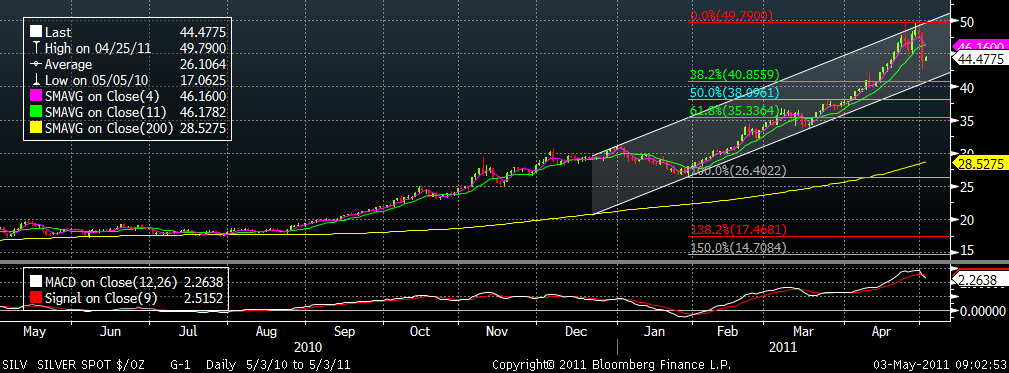Silver is not probably one of the metals you watch. While we hear about the price of gold all the time Silver is in many ways the poor cousin. But if there was ever going to be a useable metallic standard it would probably be silver rather than gold. This fact has been picked up over the past few months by “spread traders” who, seeing Gold’s stellar rally, thought they’d buy up silver.
There has been a lot of speculation in this market as the series of charts below on the silver market, monthly for 20 years, weekly for 10 and daily for the past year show. Speculation of this kind is unhelpful in any market because speculators ultimately feel gravity’s impact more heavily than end users (Everready, Duracell etc) who consume the product or longer term investors. It’s why market crashes accelerate. The specs are just getting stopped out and have no option but to sell or get closed out.
What you see when you look at the longer term charts is that they are in serious nose-bleed territory both in terms of price and momentum indicators.



Clearly the exchanges and no doubt the CFTC (Commodity Futures Trading Commission – the US body that regulates futures markets) agrees.
CNBC yesterday ran a story saying:
The CME Group (Chicago Mercantile Exchange ) has raised margins three times in a week, making it more expensive for traders to place speculative bets. The latest hike raises initial margins on speculative positions in silver future by another 12% as of close of business Tuesday, May 3.
Initial margins mean that traders need to put down more of a deposit when they enter the market which has the effect of reducing the leverage available to them for any level of capital.
Silver was up 88.58% this year until the high last week and up 28% in April alone. The impact of this news was clear in trade yesterday with a precipitous fall and silver is now down 15% from the high.
The importance of silver in the broader context can not be underestimated. In its own way, the CME is fighting against the impact and distorions of Quantitative Easing. It is taking control, or at least, trying to take control, of its market, to prevent speculators running riot. It’s a trend that is occurring in some home currency markets and a trend that will likely broaden if the USD weakens any further.
Throw in a paradign shift towards real and perceived shortages in various commodity markets and you can expect much more of this kind of regulatory intervention.